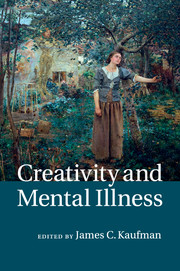Book contents
- Frontmatter
- Dedication
- Contents
- List of figures
- List of tables
- List of contributors
- Preface
- Acknowledgments
- Part I Creativity and mental illness: the state of the field
- 1 A socio-historical overview of the creativity–pathology connection: from antiquity to contemporary times1
- 2 The mad (creative) genius: what do we know after a century of historiometric research?
- 3 Reviewing recent empirical findings on creativity and mental illness
- 4 Building connections on sand: the cautionary chapter
- Part II Cognitive and neuroscientific perspectives on creativity and mental illness
- Part III Creativity and the spectrum of mental illness
- Part IV Creativity and mental illness: possible commonalities
- Part V Creativity and mental health
- Part VI Creativity and mental illness: what now?
- Index
- References
3 - Reviewing recent empirical findings on creativity and mental illness
from Part I - Creativity and mental illness: the state of the field
Published online by Cambridge University Press: 05 August 2014
- Frontmatter
- Dedication
- Contents
- List of figures
- List of tables
- List of contributors
- Preface
- Acknowledgments
- Part I Creativity and mental illness: the state of the field
- 1 A socio-historical overview of the creativity–pathology connection: from antiquity to contemporary times1
- 2 The mad (creative) genius: what do we know after a century of historiometric research?
- 3 Reviewing recent empirical findings on creativity and mental illness
- 4 Building connections on sand: the cautionary chapter
- Part II Cognitive and neuroscientific perspectives on creativity and mental illness
- Part III Creativity and the spectrum of mental illness
- Part IV Creativity and mental illness: possible commonalities
- Part V Creativity and mental health
- Part VI Creativity and mental illness: what now?
- Index
- References
Summary
Given that the entire book is devoted to creativity and mental illness, we view this chapter as a chance to highlight key work on the topic and raise some of the questions that will be addressed later in these pages. The historical antecedents of the debate have already been discussed (Becker, this volume), and the previous chapter highlighted the extensive historiometric studies conducted on this topic. Here, therefore, we will primarily focus on empirical research. Many of the studies discussed here are by scholars who have also contributed to this volume; similarly, other chapters have covered specific topics in great detail. We will only briefly allude to this work and instead send interested readers to the relevant parts of this book.
Conceptions of creativity
The connection between creativity and mental illness has been widely debated, both in creativity research and across many other disciplines. One of the biggest sources of variability and conflicting results is the problem of definitions: What exactly do we mean by creativity? Standard definitions of creativity often specify novelty and task-appropriateness (Amabile, 1996; Barron, 1955). Some also include a third concept, such as whether something is surprising (Simonton, 2013) or of high quality (Sternberg et al., 2003). Yet such broad conceptions invariably raise more questions than they answer. In order to interpret empirical results cohesively, there must be a way in which studies of creativity and mental illness define creativity. Certainly, such studies do not consistently highlight how they operationally define creativity (similar to most papers on creativity; see Plucker et al., 2004). Beyond definitions, there are many theories on how to measure creativity, from divergent thinking to remote associations to consensual assessment (Kaufman et al., 2012). Countless further dimensions may be derived from these measures, such as fluency, flexibility, unusual responses, originality, novelty, functionality, aesthetics, or remoteness of associations.
- Type
- Chapter
- Information
- Creativity and Mental Illness , pp. 42 - 59Publisher: Cambridge University PressPrint publication year: 2014
References
- 1
- Cited by



